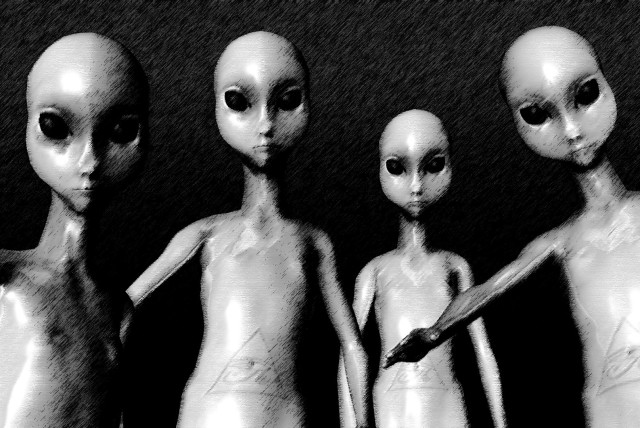Aliens may be looking for Earth but can't find us - study

Humanity has been looking for aliens for decades but has yet to find any evidence. A new study suggests we may just be in a sort of cosmic blind spot for alien radio signals.
The possible existence of alien life is one of the most fascinating and tantalizing questions in popular science, but despite the vastness of the universe, humanity has yet to find any evidence of life among the stars. A recent study, however, proposes a theory for why extraterrestrials have yet to reach out to Earth: They just can't find us.
The findings of the study were published in the peer-reviewed academic periodical The Astronomical Journal.
Authored by Claudio Grimaldi of the Ecole Polytechnique Fédérale de Lausanne (EPFL) in Switzerland, the explanation he proposes in his study is that Earth may just reside in what is effectively a blind spot for alien radio waves.
The truth is out there... maybe: The search for alien life
The search for alien life, especially the search for extraterrestrial intelligence (SETI), is a topic at the forefront of public consciousness when it comes to space, going all the way back to stories of UFOs.
Many scientists had looked into these reports with interest and supposed that alien life may likely exist. After all, what are the chances that out of the hundreds of billions of stars in the Milky Way Galaxy and even more planets, only Earth would develop life – not to mention other galaxies?
The most famous counter to this, aside from the prevailing lack of any evidence whatsoever, is the Fermi paradox, made by physicist Enrico Fermi when, amid conversations with other scientists about aliens, he supposedly said "But where is everybody?" Essentially, the Fermi paradox argues that if advanced alien civilizations existed, they would have found Earth by now, or at least left some conclusive evidence.
Several theories have been put forth to explain this. For instance, the zoo hypothesis argues that aliens are aware of Earth but have refrained from contacting us until we evolve naturally to the point where we are considered further advanced. Then there is the Dark Forest Theory, which posits that all alien civilizations are isolationist and paranoid, viewing other advanced civilizations as a threat and thus staying hidden from everyone else. And then there are the theories that suggest the natural state of societal evolution inevitably leads to its own self-destruction.
However, Grimaldi has put forth a new suggestion that simply put, alien radio waves just haven't reached Earth yet.
Now, what does this mean?
Grimaldi pointed out in his study that humanity has only really tried to search for aliens within the last 60 years. During this time, mankind has scanned the stars with a number of instruments, most notably radio telescopes, and has sent its own signals into space.
In the years since, however, all attempts at finding alien radio signals with technosignatures – indicating that they must have been artificially made – have yet to produce significant results. Thus far, only a few examples of radio signals defying natural explanation exist, such as the famous 1977 Wow! Signal, but they have been one-offs and not replicated.
The reason why we have yet to receive any is, according to Grimaldi, these signals are exceedingly rare, due to the possible technological disparity in the galaxy and the sparser presence of signal emitters, which can refer to not just traditional broadcasters of radio waves but any definitive technosignature, such as hypothetical alien megastructures like Dyson spheres. The author compares alien radio signals in the Milky Way in terms of frequency to a supernova.
Because of their rarity, it could take anywhere from 60 years to 2,000 years for these signals to ever reach Earth.
In other words, alien signals may reach us eventually, but right now, it's possible we're in for a very long wait.
But it is possible the situation will change eventually. While humanity may not send a lot of signals out into space intentionally, Earth does release a lot of radio signals unintentionally. A recent study noted that the Earth is essentially an anomalously bright source of radio leakage and as our technology advances, specifically our mobile phone technology and shift towards 5G, those signals will become even more pronounced and make it possible for aliens to theoretically find us and listen in on your calls.
But that, too, will take time.
So what does this mean for the future of SETI research?
The big problem, Grimaldi noted, is not that we are continuing to search for alien life, but rather we have no clue where to look throughout the vast reaches of the cosmos.
Because of that, rather than dedicating specific telescopes and missions to finding aliens, it may be best to keep on with past traditional SETI approaches: Surveying data from other astrophysics research to see if it may contain any data that could indicate the presence of alien life.
Some researchers have even theorized we may have already found such evidence, with many citing the interstellar object 'Oumuamua that defies explanation but which, according to Israeli-American astronomer Avi Loeb of Harvard University, could in fact be artificially made by another civilization.
But it may be a long time before we ever find out anything more definitive.
Jerusalem Post Store
`; document.getElementById("linkPremium").innerHTML = cont; var divWithLink = document.getElementById("premium-link"); if (divWithLink !== null && divWithLink !== 'undefined') { divWithLink.style.border = "solid 1px #cb0f3e"; divWithLink.style.textAlign = "center"; divWithLink.style.marginBottom = "15px"; divWithLink.style.marginTop = "15px"; divWithLink.style.width = "100%"; divWithLink.style.backgroundColor = "#122952"; divWithLink.style.color = "#ffffff"; divWithLink.style.lineHeight = "1.5"; } } (function (v, i) { });


